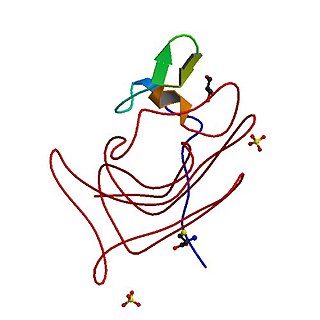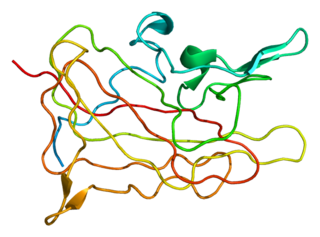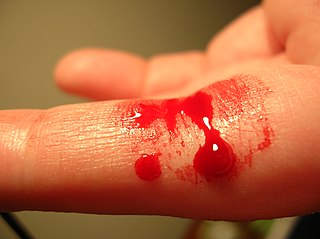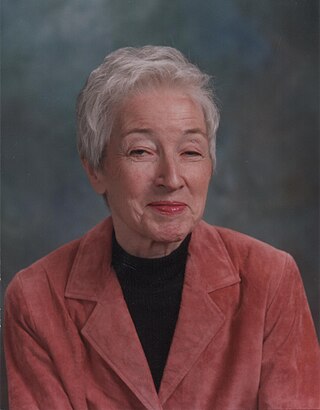Related Research Articles

Haemophilia, or hemophilia, is a mostly inherited genetic disorder that impairs the body's ability to make blood clots, a process needed to stop bleeding. This results in people bleeding for a longer time after an injury, easy bruising, and an increased risk of bleeding inside joints or the brain. Those with a mild case of the disease may have symptoms only after an accident or during surgery. Bleeding into a joint can result in permanent damage while bleeding in the brain can result in long term headaches, seizures, or a decreased level of consciousness.

Haemophilia A is a blood clotting disorder caused by a genetic deficiency in clotting factor VIII, thereby resulting in significant susceptibility to bleeding, both internally and externally. This condition occurs almost exclusively in males born to carrier mothers due to X-linked recessive inheritance. Nevertheless, rare isolated cases do emerge from de novo (spontaneous) mutations.

Haemophilia B, also spelled hemophilia B, is a blood clotting disorder causing easy bruising and bleeding due to an inherited mutation of the gene for factor IX, and resulting in a deficiency of factor IX. It is less common than factor VIII deficiency.

Von Willebrand disease (VWD) is the most common hereditary blood-clotting disorder in humans. An acquired form can sometimes result from other medical conditions. It arises from a deficiency in the quality or quantity of von Willebrand factor (VWF), a multimeric protein that is required for platelet adhesion. It is known to affect several breeds of dogs as well as humans. The three forms of VWD are hereditary, acquired, and pseudo or platelet type. The three types of hereditary VWD are VWD type 1, VWD type 2, and VWD type 3. Type 2 contains various subtypes. Platelet type VWD is also an inherited condition.

Haemophilia C (also known as plasma thromboplastin antecedent deficiency or Rosenthal syndrome) is a mild form of haemophilia affecting both sexes, due to factor XI deficiency. It predominantly occurs in Ashkenazi Jews. It is the fourth most common coagulation disorder after von Willebrand's disease and haemophilia A and B. In the United States, it is thought to affect 1 in 100,000 of the adult population, making it 10% as common as haemophilia A.

In medicine (hematology), bleeding diathesis is an unusual susceptibility to bleed (hemorrhage) mostly due to hypocoagulability, in turn caused by a coagulopathy. Therefore, this may result in the reduction of platelets being produced and leads to excessive bleeding. Several types of coagulopathy are distinguished, ranging from mild to lethal. Coagulopathy can be caused by thinning of the skin, such that the skin is weakened and is bruised easily and frequently without any trauma or injury to the body. Also, coagulopathy can be contributed by impaired wound healing or impaired clot formation.
Congenital afibrinogenemia is a rare, genetically inherited blood fibrinogen disorder in which the blood does not clot normally due to the lack of fibrinogen, a blood protein necessary for coagulation. This disorder is autosomal recessive, meaning that two unaffected parents can have a child with the disorder. The lack of fibrinogen expresses itself with excessive and, at times, uncontrollable bleeding.

Factor VII deficiency is a bleeding disorder characterized by a lack in the production of Factor VII (FVII) (proconvertin), a protein that causes blood to clot in the coagulation cascade. After a trauma factor VII initiates the process of coagulation in conjunction with tissue factor in the extrinsic pathway.
Octapharma AG, founded in 1983, is a family-owned pharmaceutical company based in Switzerland. It bills itself as "one of the largest human protein manufacturers in the world, developing and producing human proteins from human plasma and human cell lines."
Moroctocog alfa is a recombinant antihemophilic factor genetically engineered from Chinese hamster ovary (CHO) cell line. Chemically it is a glycoprotein. It is manufactured by Genetics Institute, Inc. and used to control and prevent hemorrhagic bleeding and prophylaxis associated with surgery or to reduce the number of spontaneous bleeding episodes in patients with hemophilia A. It is partially a recombinant coagulation factor VIII since it has an amino acid sequence which compares to the 90 + 80 kDa form of factor VIII (BDDrFVIII). It also has posttranslational modifications which are similar to those of the plasma-derived molecule. It can not prevent hemorrhagic bleeding associated with von Willebrand's disease since it is not a von Willebrand factor.
Recombinant factor VIIa (rfVIIa) is a form of blood factor VII that has been manufactured via recombinant technology. It is administered via an injection into a vein. It is used to treat bleeding episodes in people who have acquired haemophilia, among other indications. There are several disimilar forms, and biosimilars for each. All forms are activated.

Jeanne Marie Lusher, M.D. was an American physician, pediatric hematologist/oncologist, and a researcher in the field of bleeding disorders of childhood, and has served as the director of Hemostasis Program at the Children's Hospital of Michigan until her retirement on June 28, 2013.
Turoctocog alfa is a recombinant antihemophilic factor VIII used for the treatment of and prophylaxis of bleeding patients with haemophilia A. It is marketed by Novo Nordisk. It was approved in the United States, the European Union, and Japan in 2013.
Fereydoun Ala is an Iranian physician and academician, specialised in internal medicine, haematology, blood transfusion and haemostasis, who established the first Clinical Haematology Department, and the first Haemophilia Centre in Iran at the Tehran University Medical Faculty. He was the founder of the Iranian National Blood Transfusion Service (INBTS), a centralised, state-funded organisation, established in 1974, for the recruitment of healthy, voluntary, non-remunerated blood donors.
Acquired haemophilia A (AHA) is a rare but potentially life-threatening bleeding disorder characterized by autoantibodies directed against coagulation factor VIII. These autoantibodies constitute the most common spontaneous inhibitor to any coagulation factor and may induce spontaneous bleeding in patients with no previous history of a bleeding disorder.
Efmoroctocog alfa, sold under the brand name Elocta among others, is a medication for the treatment and prophylaxis of bleeding in people with hemophilia A. Efmoroctocog alfa is a recombinant human coagulation factor VIII, Fc fusion protein (rFVIIIFc). It is produced by recombinant DNA technology in a human embryonic kidney (HEK) cell line.
Damoctocog alfa pegol, sold under the brand name Jivi is a recombinant DNA-derived, Factor VIII concentrate medication used to treat hemophilia A.
Valoctocogene roxaparvovec, sold under the brand name Roctavian, is a gene therapy used for the treatment of hemophilia A. It was developed by BioMarin Pharmaceutical. Valoctocogene roxaparvovec is made of a virus (AAV5) that has been modified to contain the gene for factor VIII, which is lacking in people with hemophilia A. It is an adeno-associated virus vector-based gene therapy. It is given by intravenous infusion.
The National Bleeding Disorders Foundation (NBDF) is a United States patient advocacy organization for the care and treatment of inheritable blood and bleeding disorders such as hemophilia and von Willebrand disease. Founded in 1948, NBDF, then known as the National Hemophilia Foundation, helps secure funding for treatment centers, and develops national guidelines for treatment and health care policy. The organization also serves as a central point for information on the disorders.
Efanesoctocog alfa, sold under the brand name Altuviiio, is a medication used for the treatment of hemophilia A.
References
- 1 2 O'Mahony, B. (October 2004). "WFH: back to the future" . Haemophilia. 10 (s4): 1–8. doi:10.1111/j.1365-2516.2004.00981.x. ISSN 1351-8216. PMID 15479364. S2CID 25043790.
World Federation of Hemophilia, Montreal, Quebec, Canada...the WFH headquarters at the address above.
- 1 2 Pierce, Glenn F.; Adediran, Megan; Diop, Saliou; Dunn, Amy L.; Ekiaby, Magdy El; Kaczmarek, Radoslaw; Konkle, Barbara A.; Pipe, Steven W.; Skinner, Mark W.; Valentino, Leonard A.; Robinson, Fiona; Ampartzidis, Georgios; Martin, Jayson; Haffar, Assad (2022-09-01). "Achieving access to haemophilia care in low-income and lower-middle-income countries: expanded Humanitarian Aid Program of the World Federation of Hemophilia after 5 years" . The Lancet Haematology. 9 (9): e689–e697. doi:10.1016/S2352-3026(22)00209-5. ISSN 2352-3026. PMID 36055333. S2CID 251960105.
The World Federation of Hemophilia (WFH) was created in 1963, and, nowadays, it includes national member organisations from 147 countries.
- ↑ "Governance - World Federation of Hemophilia" . Retrieved 2021-05-27.
- ↑ "Vision and Mission - World Federation of Hemophilia". www.wfh.org. Retrieved 2020-04-16.
- ↑ Raabe, Michelle (2008). Hemophilia. Infobase Publishing. p. 123. ISBN 978-0-7910-9648-2.
The WFH is an international, not-for profit organization that works to improve standards of treatment, promote advocacy, provide education, and advance medical research concerning hemophilia.
- ↑ Venkataraman, Lakshmi (16 April 2019). "World Hemophilia Day - Reaching Out". Medindia. Retrieved 2023-04-18.
World Hemophilia Day 2019 aims to reach out as far and wide as possible to ensure proper diagnosis and treatment to nearly 75 percent of patients who still remain undiagnosed or don't have access to treatment.
- ↑ "Fast Facts". National Hemophilia Foundation. 2014-03-04. Retrieved 2020-04-16.
- ↑ James, Andra H. (7 May 2008). 100 Questions and Answers about Von Willebrand Disease. Jones & Bartlett Learning. p. 117. ISBN 978-0-7637-5767-0. LCCN 2008011434.
The World Federation of Hemophilia (WFH) was established in 1963 by Frank Schnabel, a Montreal businessman born with severe hemophilia A.
- ↑ "History - World Federation of Hemophilia". www.wfh.org. Retrieved 2020-04-16.
- ↑ "World Hemophilia Day 2023 - "Access for All: Prevention of bleeds as the global standard of care"". Yahoo Finance. 17 April 2023. Retrieved 18 April 2023.
Cesar Garrido, WFH President.
- ↑ "April 17 is World Hemophilia Day". The Canadian Nurse. 111 (3): 8. April 2015. ISSN 0008-4581.
- ↑ Prep Experts, Edugorilla (15 September 2022). Current Affairs Banking Notes : A Complete Current Affairs Preparation Book for All Banking Related Exams (ebook). EduGorilla.
World Hemophilia Day is aimed at raising awareness about haemophilia and other bleeding disorders.
- ↑ "World Haemophilia Day 2023: Theme, History, Significance, Full Details". Business Standard . 17 April 2023. Retrieved 19 April 2023.
The World Federation of Haemophilia (WHF) started the day observed on April 17th...to raise awareness and funds for those who cannot afford treatment for this disease.
- ↑ "WHD 2020". www.worldhemophiliaday.org. Archived from the original on 2020-04-23. Retrieved 2020-04-16.
- ↑ Testbook.com (May 2019). Current Affairs Capsule April 2019. Testbook.com. p. 7.
April 17 is observed as the World Haemophilia Day every year...It was started in 1989 by the World Federation of Hemophilia (WFH) which chose to bring the community together on April 17 in honour of WHF founder Frank Schnabel's birthday.
- ↑ "World Haemophilia Day 2023: Importance, theme, and all you need to know about the medical condition". India Today. 17 April 2023. Retrieved 2023-04-18.
The theme of World Haemophilia Day 2023 is "Access for All: Prevention of Bleeds as the global standard of Care".
- ↑ Learning, Power (2022-10-29). Current Affairs Manual 2022. Diamond Pocket Books Pvt Ltd. p. 51. ISBN 978-93-5684-123-9.
17th April 2022 - World Hemophilia Day - Theme: "Access for All: Partnership. Policy. Progress. Engaging your government, integrating inherited bleeding disorders into national policy".
- ↑ "World Hemophilia Day 2021 - World Federation of Hemophilia". www.wfh.org. Retrieved 2021-05-27.
- ↑ Hemophilia, World Federation of (17 April 2020). "World Hemophilia Day 2020" (Press Release). PR Newswire US. Retrieved 2023-04-19.
The theme of World Hemophilia Day in 2020 is "Get+involved".
- ↑ Dennis, Aaron (2018-04-17). "World Haemophilia Day 2018". The Haemophilia Society. Retrieved 2023-04-19.
We are also promoting the World Haemophilia Day theme that sharing knowledge makes us stronger.
- ↑ "Bioverativ Joins in Celebration of World Hemophilia Day". Business Wire (Press Release). 17 April 2017. Retrieved 19 April 2023.
- ↑ "European Haemophilia Consortium (EHC)" . Retrieved 2023-04-19.
This year's EHC celebration was in line with the theme proposed by the World Federation of Hemophilia (WFH): 'Treatment for all, the vision of all.'
- ↑ "World Hemophilia Day 2010". World Federation of Hemophilia. Archived from the original on 2010-04-04. Retrieved 2010-04-17.
- ↑ "World Hemophilia Day 2009". World Federation of Hemophilia. Archived from the original on 2012-02-22. Retrieved 2010-04-17.
- ↑ "World Hemophilia Day - 2008" . Retrieved 2010-04-17.
- ↑ "World Hemophilia Day". Archived from the original on 2011-03-24. Retrieved 2010-04-17.